The fourth generation Kia Rio adopts a more attractive design, which adopts the proportions that are becoming more popular: it is lower, wider and longer, and the wheelbase has been lengthened. The result is a more spacious car - among the best in its class - with a larger boot and an improved driving feel. Also, if you look at it with four or five drinks it can look like an A-Class, at least in profile. It's powerfully reminiscent of the Auris (E150) with that strong C-pillar, although it has less presence than the previous Rio.
All Rio's have the upper grille covered, as well as underbody panels to improve Cx (0.316).
I missed the third generation, but I distinctly remember the second generation model. Back then Kia still dared to bring sedan versions to Spain, as with the first generation. Those models have been lost, like tears in the rain. The new Rio is a much better placed car in its category, with stronger sales arguments. There is a sedan version but we won't see it here. We won't see a three-door either, as the previous generation had only a 10% share and has been dropped. We'll see more interesting versions in a few months, with five doors.
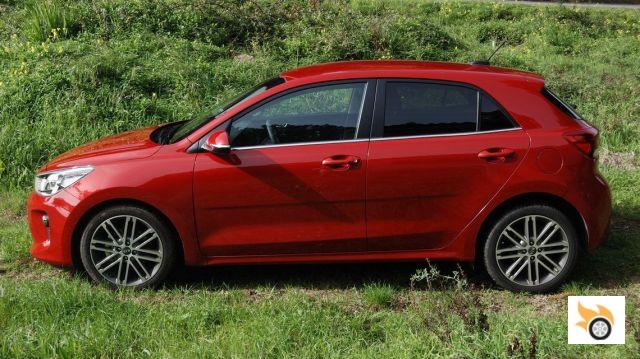
Kia wanted to give it a more robust look, more quality, more presence on the road. Several details make it clear that this effort is noticeable, such as the 30% more rigid body by increasing to more than 50% the amount of very high strength steels. It should be remembered that Kia belongs to the Hyundai Group, and among other things, have steel mills, steel is provided internally. Soundproofing has also been improved in general, as well as the perceived quality. When it comes to driving, all this is noticeable.
That effort is completely undermined by other details. The glovebox drops like a lead, especially if you have the instruction manuals in all the European and Middle Earth languages, and it hurts if you're not paying attention, I put a tweet about it (with video). The sun visors, when closed, give a bump on the roof, very Dacia everything. In the same car the sun visor holder has delayed opening and a hole to place the mobile, with rubber surface, which keeps it very well held. Who can understand it?
It has 1,070 mm for the legs, 1,375 mm for the shoulders and 1,020 mm for the head in the front seats. In the rear these dimensions are 850, 1,355 and 964 mm, respectively. I find it very habitable in general, if the front seats are not thrown back to their rearmost position I'll be comfortable with a fully average height. In the side seats there is an acceptable support, in the middle not, but this is very common, not a defect of this model. I found the front seats to be great.
The boot capacity is 325 litres, which is 37 litres more than the previous model, although it has a shorter rear overhang.
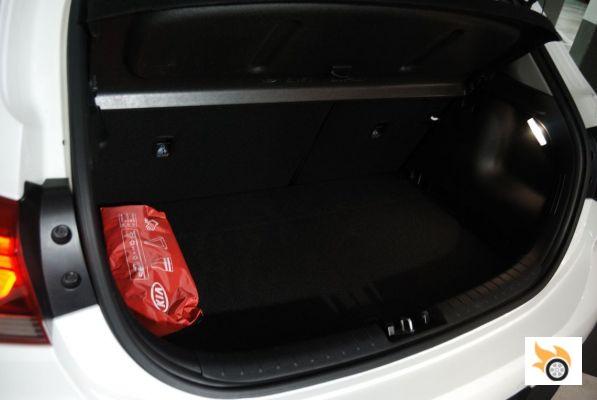
There are two instrument panels, depending on the trim, the simpler one looks like it was designed 10 years ago, and the more modern one has a 3.5-inch screen with various information, colours and animation. In this car it's a nice touch, but it's not essential. On the first test drive the boot didn't close properly (you have to give it a bit of a go) and the open boot warning was so discreet that neither the first driver nor I noticed it for quite a while. There were no beeps, but there was an animation that we didn't pay much attention to.
It's a nice touch that the steering wheel is adjustable in height and depth from the basic model!
From the intermediate version onwards it has a touchscreen for the human-machine interface (HMI) to control the sound system, navigation and some integrated applications. The system requires a WiFi connection to be able to work at its best, such as getting real-time traffic jam location or knowing the weather forecast. We'll have to share the phone's data connection. Those who have an Android 5 (or higher) or an iPhone compatible with CarPlay, will have additional functions. So you can use some applications directly with that screen, and leave the phone out of sight, for greater security.
This car has a very cool technological detail, and that is that it has a USB connector for the rear seats, only for charging. In a modern car that's more important than an ashtray, times change. I like how the orientation of the controls has been solved, and that you don't have to put your hand inside the steering wheel rim to touch the on-board computer. Ergonomically I am convinced, it is a comfortable and pleasant car to drive, and with the steering wheel controls many functions do not involve removing your hands from where they should be. The touch screen is very well placed, you can tell it's a modern design.

In the Spanish market the interiors are going to be either black or black/grey, i.e. as sad as ever. In the test units deployed in Portugal there were some two-tone with synthetic leather, very cool, but that will not be offered in Spain. It's a shame, there are many B-segment models that offer a touch of joy and color in the interiors, and here the Rio is too rational. By the way, the gear lever on the basic petrol is shaped like a ball, I liked it better than the more squared-off six-speed knob.
There are pockets everywhere to empty your pockets. The front doors can hold one and a half litre drinks, the rear ones half a litre. There are two drinks compartments between the front seats as well. In the glove box there is a single compartment, and I advise not to place anything heavy to avoid a violent lowering of the glove box, it is not delayed. Under the climate control you can place the mobile phone so that it doesn't move around, near the cable to charge it.
Most of the materials are hard, it is the usual of the segment, although we are beginning to find models in the competition that place padding in the most obvious areas. The fit seems good and there are no obvious defects in the finish. That contrasts with the fact that sometimes the doors or the trunk don't close with the usual force. Anyway, the overall impression the Rio gives is good, especially when looking back. The second generation Kia Rio felt more out of place compared to what was on offer at the time.
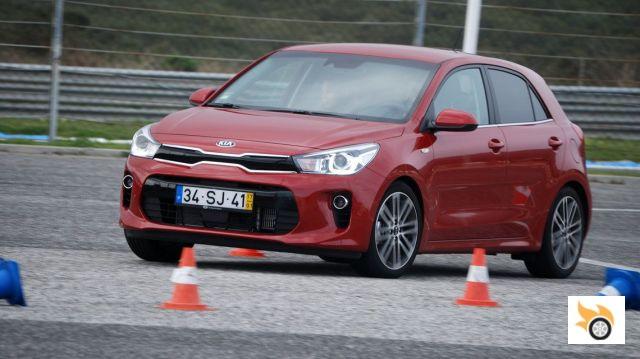
Improved handling and driving feel
The engineers have put in the hours to make the driving feel more European, more precise. As the body is stiffer, with particular attention paid to the front subframe, the suspension has been retuned to be more docile. Certainly the Rio handles well and fast, as we tested it in the paddock of the Estoril Circuit on cone courses that we did at full speed with minimal space. By the way, Pistonudos set the best time in the skill circuit test with giant ball chut included, 32.3 seconds. In that test we checked the car's manoeuvrability and agility.
By the way, yes, it is very agile, but I found the steering very soft at low speed, so much so, that in one of the bumps I used too much force and gave me a wiggle in the right testicle. At higher speeds the steering gets a bit harder, but I'm not convinced at low speed. However, for parking it's an obvious advantage. I would prefer a button that alternates the hardness, like Fiat's CITY. The steering wheel tracks with precision and you don't have the sensation of being isolated from the road, although it did give me that feeling.
It has a comfortable suspension and holds the car well when driving like a normal person. There is some swaying when you roll with a knife, but keep in mind that this car is made to appeal to everyone, as the B-segment covers all age groups, and did not intend to make a thoroughbred. For what is a car of this type convinces me, it goes very well. The rear suspension is a bit drier than the front, but that's normal in cars with McPherson front and rear torsional axle.
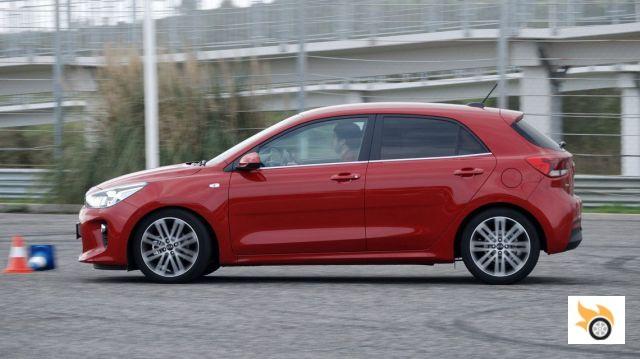
One of the tests in the circuit area included emergency braking with dodging. I was surprised at how little space it needed for braking and how stable it was in the turn search, done at just over 70 km/h with three people on board. In fact, it braked so fast that I didn't even put the pedal to the floor the first time. On a second repetition I managed a more forceful stop, but I had to use more force than usual when braking. I think the brake servo should be given a few more newtons of assistance. In reality this has to come out first time, there's no time for practice.
The new Rio's suspension secrets include new McPherson struts, a raised torsional axle, vertical rear shocks, and front shocks with preloaded linear valves. According to the manufacturer, steering response and driving pleasure on bumpy roads are improved. Overall the Rio is very comfortable.
As for the stability control, VSM in this brand, it works in a timely manner. It doesn't react strangely, it does what you expect it to do. Soon there will be a sportier version, GT Line, with 1.0 T-GDi 120 hp engine and a more aggressive aesthetic. Of course the base is more than fine. It may not be the sportiest in the segment, but it will appeal to people who wouldn't have considered buying a Kia before.
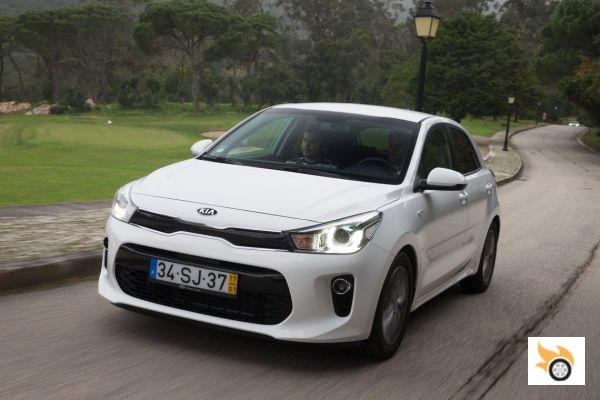
Here are its engines
1.25 CVVT engine
The youngest of the range is a naturally aspirated 1,248 cc, the same displacement as Fiat's 1.3 MultiJet (they have nothing else in common) and four cylinders. It is a type of engine in extinction, but that will give good service in the Kia Rio. With 84 hp of power and a five-speed gearbox it has what is necessary for a car in this class, correct performance, easy maintenance and very reasonable consumption.
In fact, it's the most recommendable petrol in the range in my humble opinion, as it's perfectly balanced, quiet and doesn't vibrate. When you rev it up to get more acceleration it obviously sounds more, but it's not an ugly sound. The naturally aspirated engine means using the gear lever with agility to get the best response, because at low revs it holds but accelerates little.
In the short test drive, with two passengers and some ramps at 80-90 km / h, the Rio climbs with enough desire and if the fifth is stuck, down to fourth and up. The faster we go, the better it copes, as the maximum torque is at 4,000 revs. I find very remarkable the fact that consumption is very contained with this engine, my test partner and I did an average of only 5.1 l/100 km of gasoline having rolled at the same pace as the Lisbon traffic, and we would lie if we said that no acceleration was taken.
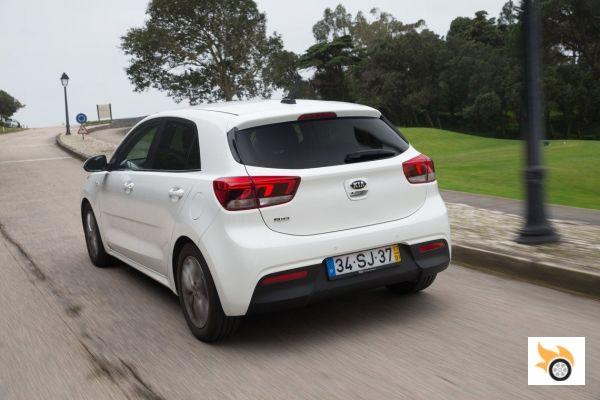
1.4 CRDi engine (90 PS)
How's the little cauldron doing? Much better than expected. With a maximum torque of 240 Nm between 1,500 and 2,500 RPM, it's a very elastic engine that greatly reduces the need to change gears, and responds surprisingly well at any rpm. Even starting from just over 1,000, it gains speed without complaint, without annoying vibrations and without unpleasant noise. What's more, it seems to me the most recommendable engine of the whole range.
I not only recommend it to those who are looking for the lowest consumption - since it still asks for less than a petrol - but also to those who want an engine with good response in general. In some models, choosing petrol or diesel is like choosing a blonde or a brunette, that is to say, it's totally a function of taste, knowing that a blonde is not per se better than a brunette and vice versa. Who says blonde or brunette also says navy blue or black, so no one should feel discriminated against.
The 77 hp version of this engine has the same maximum torque, but fixed geometry turbo instead of variable geometry (WGT).
I drove with this engine with three adults on board, unusual for a presentation, but we got three colleagues together who tuned in well. Even with the increased weight the car goes like a shot with 90 hp, and even allows to have fun in curvy sections -like a local rally- without having the constant feeling that the engine is dead. I can't talk about fuel consumption here, because we gave it so much mileage that the average went up to 6.5 l/100 km and that's not representative at all. However, I can tell you that driving smoothly I got 3.8 l/100 km without any difficulty.
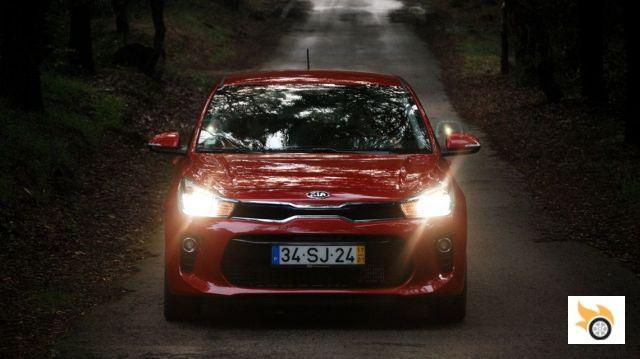
1.0 T-GDI engine (100 hp)
Finally, the new generation three-cylinder engine. I had my first contact with this newly developed engine family in the Kia cee'd and I must remember that I wasn't convinced at all. I found it not very elastic and with a consumption very variable to the use. In the Rio I think the same. The gears are longer than a decade without having sex, suffice it to say that the second short at almost 110 km / h, and that the third, fourth and fifth can leave us sold if we do not change quickly. Like the 1.25, the gearbox has five gears. Next year an automatic with robotized dual clutch will be available.
At low revs this engine is drowned, something obvious if we consider its low displacement. The same thing happens to Ford's EcoBoost, only the 140 hp version saves the situation by blowing the turbine more. It feels comfortable at higher revs. The 1.0 three-cylinder Volkswagen (1.0 TSI) and Opel (1.0 SIDI) have seemed much more satisfactory in elasticity, and why not say it, in pleasure of use. This is the typical three-cylinder that vibrates, transfers the vibrations to the interior and reduces the perceived quality of the whole car. It would like to be as refined as the diesel. It also has the problem that it barely holds downhill, so you have to use the brakes more often, even in second gear it can bog down at low speed!
It spent between 7 and 9 l/100 km (worst case), a naturally aspirated car can easily improve that.
Sorry, I don't like it. What's more, I think it's a mistake for Kia not to offer the naturally aspirated 1.4 CVVT with the same power - the cee'd does offer both engines - as the four-cylinder is more pleasant to use, vibrates much less and in certain circumstances I'd bet my skin that it uses less petrol. Of course, this engine homologates less CO2, so the debate ends here. On paper it's a good engine to sell because it benefits the manufacturer. To the environment certainly not, the CO2 does not lower it, but the particulate emission rises fabric, as they have not put filter despite having developed it, for Euro 6b is not necessary. Direct injection, turbo and low displacement is a fatal combination for exhaust quality.
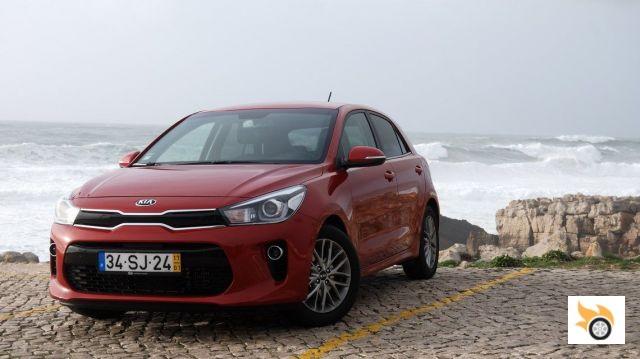
Spanish range
Until April will not arrive at the dealers, but we can give prices. The range starts with the 1.25 Concept, 10,909 euros with a promotional discount of 2,300 euros and a reduction of 750 euros in exchange for financing (which is a hidden interest reduction). Three trim levels: Concept, Drive and Tech, associated with all engines, with the only exception of the top trim for the 77 hp diesel. The 1.4 CVVT engine is not offered in Spain, nor sedan body. There are no automatics. The most expensive comes at 16,209 euros (1.4 CRDi 90 Tech), in the same conditions of promotional discount and financing.
The Concept trim features 15″ tyres with alloy wheels (the 1.25 goes with hubcaps), temporary spare wheel, light sensor, basic safety systems, basic connectivity (Bluetooth, auxiliary and USB), air conditioning, electric door mirrors, depth and height adjustable steering wheel, and height adjustable driver's seat. The 1.0 T-GDI and 1.4 CRDi also add LED daytime running lights and front fog lights.
The Rio is available in eight popular colours.
On the next step up, Drive, the grille has a chrome surround, and the door mirrors and door handles are body-coloured. Inside we will find rain sensor, parking sensors, electric rear windows, automatic climate control, steering wheel and gear knob with leather, rear USB charger, smartphone connectivity (Android Auto and Apple CarPlay), rear parking camera, TomTom connected services (7 years), browser with 7″ screen and electrically folding exterior mirrors with integrated turn signal.
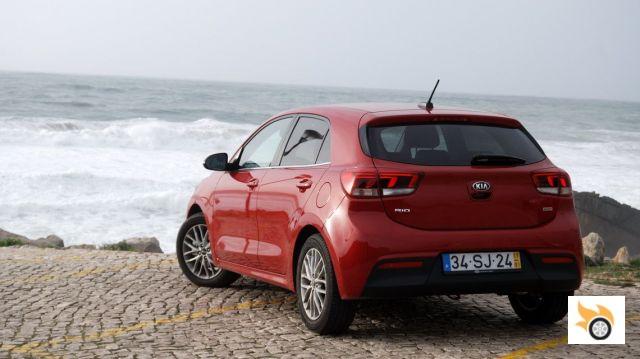
Finally, the Tech completes the endowment with 17″ tires with alloy wheels, net fastening in the trunk, dashboard with 3.5″ TFT screen, tinted windows, LED rear lights, automatic anti-dazzle rearview mirror and lane keeping systems and emergency braking assistant with pedestrian detection. Rear Cross Traffic Alert (RCTA) and Blind Spot Warning (BSM) will be available at a later date.
The Kia Rio comes with a seven-year warranty or 150,000 kilometers, and the manufacturer assures that it honors that warranty even if the customer never visits an official service center. Of course, the workshop on duty will have to follow all the brand's procedures - the mechanic doesn't need specific training - in time and on time. I had always thought that this warranty meant that the customer was married to Kia for seven years, but no, European legislation obliges them even if it is a warranty above what is required by law.
Until the new Rio arrives, Kia has enough stock of the outgoing model to meet demand.

























